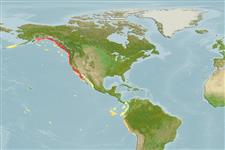Elasmobranchii (sharks and rays) >
Carcharhiniformes (Ground sharks) >
Pentanchidae (Deepwater catsharks)
Etymology: Apristurus: a-, Latin privative, i.e., without; pristis, from pristes (Gr.), sawyer (but here meaning saw); oura (Gr.), tail, referring to absence of saw-toothed crest of enlarged dermal denticles along upper edge of caudal fin as found in the closely related Pristiurus (=Galeus). (See ETYFish); brunneus: Medieval Latin for brown, referring to its “uniform warm brown” color above and below. (See ETYFish).
More on author: Gilbert.
Environment: milieu / climate zone / depth range / distribution range
Ecology
Marine; demersal; depth range 33 - 1306 m (Ref. 96339). Subtropical; 60°N - 39°S, 138°W - 70°W (Ref. 56871)
Eastern Pacific: British Columbia, Canada to northern Baja California, Mexico. Probably south to Panama, Ecuador, and Peru.
Size / Weight / Age
Maturity: Lm ? range ? - ? cm
Max length : 69.0 cm TL male/unsexed; (Ref. 96339)
Short description
Morphology | Morphometrics
Inhabits the outer continental shelf and upper slope (Ref. 244). Found over muddy or sandy bottoms (Ref. 27436). Feeds on small true shrimps, euphausiid shrimps, squids, and small fishes (Ref. 244). Oviparous (Ref. 50449).
Life cycle and mating behavior
Maturity | Reproduction | Spawning | Eggs | Fecundity | Larvae
Oviparous, with a single egg per oviduct (Ref. 244). Eggs are enclosed in oblong transparent cases with tendrils at each end (Ref. 6885). Embryos feed solely on yolk (Ref. 50449). In Canada, females carry egg cases from February to August (Ref. 244).
Compagno, L.J.V., 1984. FAO Species Catalogue. Vol. 4. Sharks of the world. An annotated and illustrated catalogue of shark species known to date. Part 2 - Carcharhiniformes. FAO Fish. Synop. 125(4/2):251-655. Rome: FAO. (Ref. 244)
IUCN Red List Status (Ref. 130435)
Threat to humans
Harmless
Human uses
Fisheries: of no interest
More information
Age/SizeGrowthLength-weightLength-lengthLength-frequenciesMorphometricsMorphologyLarvaeLarval dynamicsRecruitmentAbundanceBRUVS
ReferencesAquacultureAquaculture profileStrainsGeneticsElectrophoresesHeritabilityDiseasesProcessingNutrientsMass conversion
Tools
Warning: mysqli::__construct(): (08004/1040): Too many connections in /var/www/html/includes/speciessummary.lib.php on line 2414
Can't connect to MySQL database fbquizv2. Errorcode: Too many connections
